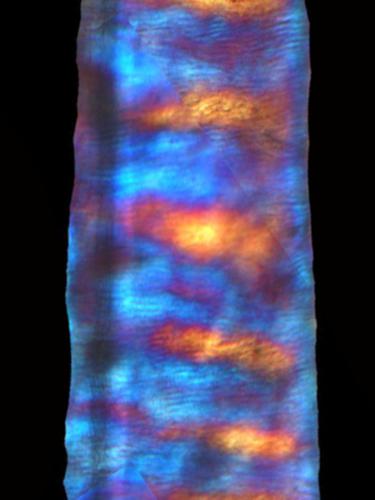当前位置:
X-MOL 学术
›
Am. J. Primatol.
›
论文详情
Our official English website, www.x-mol.net, welcomes your
feedback! (Note: you will need to create a separate account there.)
Quantification of enamel decussation in gracile and robust capuchins (Cebus, Sapajus, Cebidae, Platyrrhini)
American Journal of Primatology ( IF 2.0 ) Pub Date : 2021-02-27 , DOI: 10.1002/ajp.23246 Russell T Hogg 1 , Abdallah Elokda 2
American Journal of Primatology ( IF 2.0 ) Pub Date : 2021-02-27 , DOI: 10.1002/ajp.23246 Russell T Hogg 1 , Abdallah Elokda 2
Affiliation

|
Multiple behavioral and biomechanical analyses have demonstrated that capuchin monkeys (Cebus and Sapajus) are specialized for breaking down hard‐object foods as compared to other cebid monkeys. In addition to a complex suite of craniodental adaptations, it has specifically been demonstrated that capuchins possess highly complex dental enamel, with extensive Hunter–Schreger banding and other decussation, that likely serve as an adaptation to resist crack propagation during hard‐object feeding. Furthermore, it has been demonstrated that robust capuchins (Sapajus spp., formerly Cebus apella) demonstrate further adaptation for hard‐object feeding than other capuchins, routinely breaking down extremely mechanically challenging foods. However, there has been no comparison of dental enamel complexity in robust versus gracile capuchins, to assess whether the dental enamel in Sapajus follows this same pattern of further specialization. Therefore, this study compares dental enamel complexity in images of dental thin sections from a sample of robust versus gracile capuchins using image compression ratio (ICR) analysis. ICR is a variable that correlates with enamel complexity, such that higher ICR values are indicative of increased complexity in the form of enamel decussation. We found no significant difference between robust and gracile capuchins when assessing all teeth in our sample together, however, we did find that robust capuchins have significantly higher ICR values than gracile capuchins for canine teeth, specifically. Our results support prior studies suggesting that robust capuchins are specialized to generate increased masticatory loads with their anterior dentition, specifically, as compared to gracile species.
中文翻译:

纤细和健壮卷尾猴(Cebus、Sapajus、Cebidae、Platyrrhini)中牙釉质的量化
多项行为和生物力学分析表明,卷尾猴(Cebus和Sapajus)与其他 cebid 猴相比,更擅长分解坚硬的食物。除了一系列复杂的颅牙适应外,还特别证明卷尾猴具有高度复杂的牙釉质,具有广泛的亨特-施雷格条纹和其他交叉,这可能是在硬物进食过程中抵抗裂纹扩展的一种适应。此外,已经证明强壮的卷尾猴(Sapajus spp.,以前的Cebus apella) 表现出比其他卷尾猴更适应硬物进食,经常分解极具机械挑战性的食物。然而,没有比较健壮卷尾猴与纤细卷尾猴的牙釉质复杂性,以评估Sapajus 的牙釉质是否遵循同样的进一步专业化模式。因此,本研究使用图像压缩比 (ICR) 分析比较了坚固与纤细卷尾猴样本的牙齿薄切片图像中的牙釉质复杂性。ICR 是一个与牙釉质复杂性相关的变量,因此较高的 ICR 值表明牙釉质分层形式的复杂性增加。当一起评估我们样本中的所有牙齿时,我们发现健壮卷尾猴和纤细卷尾猴之间没有显着差异,但是,我们确实发现健壮卷尾猴比犬齿的纤细卷尾猴具有显着更高的 ICR 值,特别是。我们的结果支持先前的研究,表明与纤细的物种相比,强壮的卷尾猴专门通过前牙列产生增加的咀嚼负荷。
更新日期:2021-04-29
中文翻译:

纤细和健壮卷尾猴(Cebus、Sapajus、Cebidae、Platyrrhini)中牙釉质的量化
多项行为和生物力学分析表明,卷尾猴(Cebus和Sapajus)与其他 cebid 猴相比,更擅长分解坚硬的食物。除了一系列复杂的颅牙适应外,还特别证明卷尾猴具有高度复杂的牙釉质,具有广泛的亨特-施雷格条纹和其他交叉,这可能是在硬物进食过程中抵抗裂纹扩展的一种适应。此外,已经证明强壮的卷尾猴(Sapajus spp.,以前的Cebus apella) 表现出比其他卷尾猴更适应硬物进食,经常分解极具机械挑战性的食物。然而,没有比较健壮卷尾猴与纤细卷尾猴的牙釉质复杂性,以评估Sapajus 的牙釉质是否遵循同样的进一步专业化模式。因此,本研究使用图像压缩比 (ICR) 分析比较了坚固与纤细卷尾猴样本的牙齿薄切片图像中的牙釉质复杂性。ICR 是一个与牙釉质复杂性相关的变量,因此较高的 ICR 值表明牙釉质分层形式的复杂性增加。当一起评估我们样本中的所有牙齿时,我们发现健壮卷尾猴和纤细卷尾猴之间没有显着差异,但是,我们确实发现健壮卷尾猴比犬齿的纤细卷尾猴具有显着更高的 ICR 值,特别是。我们的结果支持先前的研究,表明与纤细的物种相比,强壮的卷尾猴专门通过前牙列产生增加的咀嚼负荷。











































 京公网安备 11010802027423号
京公网安备 11010802027423号